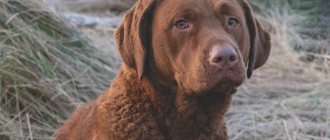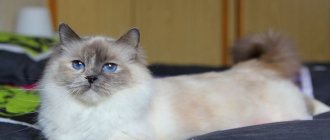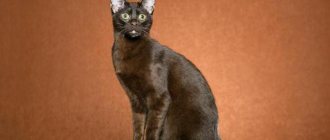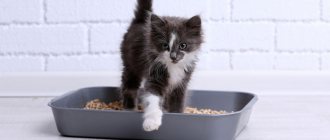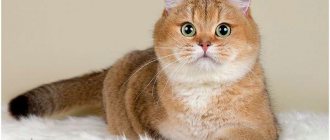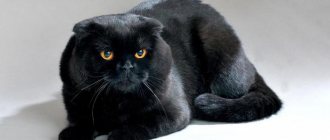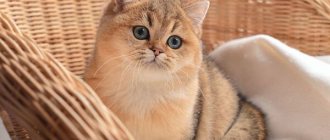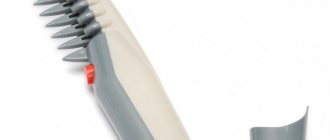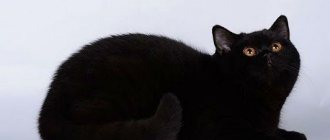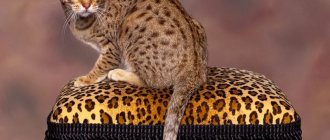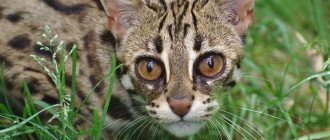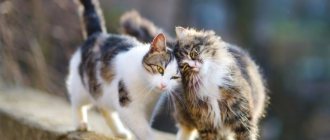Home » Cat Breeds
Sweet plush British cats, the only owners of “Cheshire” smiles among the entire cat tribe, resemble soft toys, and especially bear cubs. The standard of this breed allows a large number of colors (according to the latest data, more than sixty). Chocolate color is relatively new and still rare.
- 2 What is color and how new colors are developed
- 3 History of the breeding of British chocolate
- 4 Chocolate color standards for the British
4.1 Table: EMS encodings according to international standards WCF and FIFe
- 7.1 Video: British chocolate kitten
Who are the British
All representatives of the British breed, regardless of color, are distinguished by a rather massive and muscular physique. The body is compact, round and very harmoniously designed, with a wide, large chest and slightly short, strong legs. The average weight of males is 6–8 kg, but sometimes reaches 10 kg. Females are much smaller and lighter.
British cats have a massive build
The British have a large round head on a massive neck, with thick convex cheeks and a firm, pronounced chin. The ears are straight, medium-sized, and set wide apart. The eyes are large, round and well open. The tail is not distinguished by its outstanding size; at the base it is thickened to a rounded tip and slightly narrows. The coat is extremely thick and short with good quality undercoat and is very soft and pleasant to the touch.
How many breeds are there?
There are not as many cat breeds as there are dog breeds, but there are still plenty to choose from. Even an avid cat lover cannot give the exact figure, because there are many associations and clubs in the world involved in the classification and exhibition of cat breeds. And their accepted breed standards may differ from each other, and if in one association a breed is considered recognized, then in another it will be only a branch of another.
On average, today there are over a hundred cat breeds, and together with the varieties there will be all seven hundred. Among them there are both large and small breeds, as well as with different colors and coats.
The British breed is recognized as one of the most popular in the world, and how much a kitten of the British species costs depends on a number of factors, which we will discuss below.
What is color and how are new colors developed?
The color of a cat refers to the color of the coat and the pattern on it. In general, domesticated cats are distinguished by an incredible variety of colors, unlike their wild relatives. There are not so many main genes responsible for the color of a mustachioed pet (solid color, lighteners, patterns, etc.), but their combination and various combinations create an endless number of options. Two genes are responsible for each trait, one of which is received from the mother, the other from the father. The task of a competent breeder is to correctly identify the necessary genes (dominant or recessive) and carefully select them to develop the desired shade.
History of the breeding of British chocolate
Breeders were not involved in the targeted breeding of brown fur in British cats . This color is not so common; it is characteristic of eastern representatives of the cat family (Burmese, Oriental, Siamese, etc.). The goal of the breeding work was to obtain color-point color in plush cats, for which they were crossed with color-point Persians.
The purpose of breeding the breeders was the color point color, and the chocolate color turned out to be an accident
The first chocolate Briton was born by chance in the 80s of the last century. But the color was so deep and luxurious that later breeders began to strive for a pure dark brown shade. British cats of this color are very popular.
White based colors
These colors of Scottish breeds are:
Bicolor. Two-color ones, in turn, are presented with the addition of the following colors to white: blue, black, cream, red. The muzzle, abdomen, limbs and thighs remain entirely light. The eyes are the color of gold or sky. Such tartans can have eyes of different colors.
Wang. Almost all the fur is white, only the tail and a couple of markings on the head are colored.
Harlequin. The edge is mostly white, only a fifth of the surface is colored.
Ticking. All fur with distinct ticking. The eyes are all shades of gold; those with a silver color are greenish.
Chocolate color standards for the British
There are very strict requirements for the chocolate color of British cats. According to the breed standard, the coat should be short and soft, but the structure should be elastic and not adhere to the animal’s body. A coat that is too soft and tight-fitting to the body or, conversely, a coat that is too harsh are considered serious faults. Due to the thick undercoat, the cat’s skin becomes plush, but excessive fluffiness is unacceptable.
The coat color should be a uniform deep and rich dark brown. Each hair is painted in one tone without play or flow along its entire length. The skin and undercoat are the same shade. The nose is only chocolate, but perhaps a little lighter than the main brown tone. The pads on the paws are also in dark chocolate tones. No stains, stripes, scorches or other effects are allowed by the standard. The animal must have an exceptionally even brown color, which is sometimes called chestnut, associating this color with the color of the ripe horse chestnut fruit. The saturation and density of the shade can vary from the color of a children's milk chocolate bar to a dark chocolate bar with a high cocoa content.
The coat of a Chocolate Briton should be colored evenly, without stripes, spots, marks, etc.
The color of expensive Havana cigars, which are also a rich dark brown, gave these Britons the nickname Havana.
The irises of the chocolate British are allowed only in yellow variations: from light copper to deep dark orange. Without the greenish rim often found in cats.
Chocolate Britons only have yellow eyes
Table: EMS encodings according to international standards WCF and FIFe
| Sign | Code | Name | |
| Breed | BRI | British shorthair | British Shorthair |
| Coat color | b | chocolate (brown, chestnut) | smooth brown or chestnut (chocolate) |
| Tail length | 54 | longy) | normal/long tail |
| Iris color | 62 | yellow, golden | yellow, golden, orange |
| Ears set | 71 | straight ears | straight - straight ears |
The darker and richer the chestnut color of the fur, as well as the brighter the eyes, the more valuable the cat is.
Tortoiseshell colors
The amazing thing about calico cats is that each one is unique. There are no identically colored turtles. Color types: finely spotted or patchwork, calico (spots on white). A very interesting joke of nature: only cats are tortoiseshells. Well, practically. Calico cats are much more rare than white crows. Cats can have such colors only due to a genetic error with chromosomes. Most breeders and felinologists, having worked with animals all their lives, have never encountered tricolor cats. But yes, one day such a kitten may be born. Unfortunately, there will be no offspring from him, although history knows exceptions. Turtles also include chimera cats, which amaze everyone with their appearance, whose faces are neatly painted in different colors. Chimerism is also a genetic anomaly.
There are six main subgroups of this color: classic tortoises, smoky tortoises, torbie (tortoiseshell tabby), tortie (tortoiseshell point), calico (patchwork tortoise) and mixed color (tortoiseshell tabby and white).
Bicolor tortoiseshell
This color is also called calico, or patchwork tortoiseshell. The brightest, most elegant color. On a white background there are colored spots, the boundaries of which are not blurred or mixed. The spots can be any color from the palette. Pigmented spots should cover more than a third of the body surface. If there are few colored spots on a white background, such animals are called harlequin or van.
Black and red tortoiseshell
Ideally, a cat should have approximately 50% red and 50% black spots. The brighter the spots, the better. Brownish and beige spots are the same red color, only lightened. According to the standard, a red spot on the forehead is very desirable.
Chocolate red tortoiseshell
Interesting, rarely seen color. Ideally, a cat should have approximately 50% red and 50% black spots. The brighter the spots, the better. There should be a light spot on the forehead.
Blue-cream tortoiseshell
Soft, delicate, very noble color. Pastel colors (blue and cream) blend smoothly into each other. White spots and even hairs are not allowed.
Lilac-cream tortoiseshell
Purple and cream spots are neatly distributed throughout the animal's body. White inclusions are not allowed. There should be a cream spot on the cat's face.
Cinnamon-red tortoiseshell
Rare tortoiseshell color variant. The color of the fur coat is warm and rich. The spots are evenly distributed; there should be a red spot on the animal's face.
Fawn-cream tortoiseshell
This color is rare. The spots are not bright, but nevertheless they should have a different color. White wool and residual tabby color are not allowed. But there should be a cream mark on the forehead.
Anomalies and features inherent in the British chocolate color
The chocolate color is somewhat difficult to breed. Quite often, kittens are born in litters with residual stripes or spots, as well as with lightened undercoat. Which does not meet international standards, since the wool must be dyed evenly and uniformly. In addition, it is not immediately possible to understand exactly what shade of chocolate and what quality it will be.
At a certain period of time, the babies’ fur turns brown, acquiring an ugly yellowish-dirty hue. In most cases it goes away over time, but not always. Usually, only when the kitten reaches 12–15 months, and sometimes later (up to two years), does the complete development of color occur.
Chocolate British cat kittens do not immediately acquire their true color
Where is the price higher?
If you ask how much a British kitten costs in Moscow or another metropolis, and compare the prices with the cost of kittens in the regions, you will be unpleasantly surprised. Pedigree animals in the capital will cost more than kittens from the regions.
The reason for this is clear - everything is more expensive in Moscow. But another question arises: is it worth buying kittens from the regions or paying more, but buying in the capital? And here not everything is clear.
In big cities, prices may be higher, but there is also more choice. In addition, you can find breeders who have been breeding this breed for more than one year and regularly participate in exhibitions. This means that you will be able to purchase not just a kitten from breeding parents, but also, possibly, champions of your breed. But you need to be prepared for the high cost of the animal.
In small regions there is another extreme - there are practically no professional breeders, and there is no need to talk about participation in exhibitions.
Special rules for caring for British dogs with chocolate skins
Caring for chestnut-colored animals is no different and consists of the following actions:
- Proper nutrition (varied and balanced). Both feeding options are acceptable: ready-made factory feeds of at least super premium class (preferably holistic);
- natural food
- against fleas - shampoos, drops, collars, etc.
Any violations in the maintenance of the animal and health problems immediately reduce the quality of the British coat. The wool loses its natural shine and becomes dull.
Features of genetics and mating of British chocolate dogs
It is quite difficult to obtain a real, pronounced chocolate color from a cat's fur. In order for the offspring to have a dark brown coat, a necessary condition is the presence of a certain gene in both parents . In the gene set of a chocolate baby, it must be present in double size (from the mother and from the father). That is, both parents must have the same dark brown color.
The color of an animal's fur is determined by the presence of a coloring substance (pigment) in the hairs - melanin, which is present in the hair structure in the form of varying numbers of microscopic grains (granules) of different shapes and sizes.
Kittens are born chocolate only if both parents are the same color
There are two varieties of this pigment:
- eumelanin - gives black pigmentation;
- phaeomelanin - works in the yellow and red parts of the spectrum.
Strictly speaking, there is no specific gene responsible for chocolate. When the black pigment (B) is oxidized to red-yellow, a recessive oxidized gene is obtained that colors the coat brown (b). The kitten inherits one chromosome from both ancestors, so for the appearance of a chocolate baby, the combination bb must appear.
The intensity of the shade (dilution) depends on the D gene (Dilutor - diluent). In the dominant state of this gene, the granules of the coloring pigment in the hair are tightly packed, so the color will be thick and rich. If the form is recessive, then the color turns out faded and diluted. In British chestnuts this gene is dominant (D), so their color (like blacks) is hard and dense. The recessive position (d) gives a loose color (lilac or blue).
If one of the parents does not have chocolate coloring, but is a carrier of this gene, then only half of the kittens in the litter will turn out to be chocolate . Most often, a carrier female, who does not have the required brown tint, but has this gene in her gene set, is mated with a true 100% chocolate stud male. When crossing two carriers (very often a brother and sister), a maximum of only 25% of the offspring in the litter can be chocolate. There is also a certain risk in the fact that such kittens may not turn out at all.
One litter can have kittens of different colors
Thus, the basis of selection and the greatest value are not only the real chocolate Britons themselves, but also the carriers of this gene. Since the final color of the British with chestnut coat is formed very late, you have to wait a long time. Before this, young animals cannot be used for selection.
Chocolate Britons have retained the color point color in their gene set and are carriers of this gene, so they are often used for mating with cats of this color.
A good friend of mine has a gray British cat at home. She has no pedigree, as she was bought inexpensively from some distant relatives. A cat is bred every year with the same cat found through an advertisement. A stud cat of blue color and some very good blood. Few kittens are born, usually no more than 3–4. The colors vary; there are always blue and lilac kittens in the litter. But sometimes a chocolate baby is born, to the great joy of the owner. This suggests that both the cat and the cat have the chocolate gene, that is, they are its carriers.
Video: British chocolate kitten
Where to buy kittens?
We all have a natural desire to save money, and unscrupulous people often take advantage of this. Buying a purebred animal is no exception to the rule; today such deceptions are not uncommon.
A purebred kitten cannot be cheap; if you are offered a show-class kitten, then you should immediately suspect something is wrong. Either they openly want to deceive you, or you are faced with an inexperienced cat lover who doesn’t even know all the ins and outs about the breed. In this case, immediately refuse the purchase.
Do not take kittens only based on an advertisement on the Internet; they can sell you a British kitten without documents. How much such a kitten costs is not even worth finding out, because no one can guarantee that both parents are purebred and have no defects in their pedigree.
The best purchasing option would be to contact a specialized nursery, where they will not only sell you a purebred animal, but will also give you detailed advice on raising and feeding a kitten.
Peculiarities of chocolate British participation in cat shows
If a British chocolate cat exactly meets all breed standards, is healthy and has no external physical defects, and also has the necessary documents (pedigree), then it can take part in any cat shows.
Preparations for exhibition events are carried out in advance:
- The animal is bathed (if the coat looks oily) with a special shampoo. It is recommended to use conditioner (same brand).
- Clean ears and eyes.
- Carefully trim the claws.
- Using a special brush and toothpaste, brush your pet’s teeth (2-3 days before the event).
To prevent the rich brown color from fading or fading, the animal should not be exposed to direct sunlight. Tinting and tinting wool is strictly prohibited.
The show animal must meet all breed standards
Individuals with the following deficiencies are subject to disqualification:
- white inclusions, stripes, spots or lighter undercoat (brownish or gray);
- eyes of an inappropriate shade or rim around the iris;
- not brown color of the nose and paw pads;
- excess or insufficient number of fingers;
- undershot or overshot (more than 2 mm);
- tail defects (bends, creases);
- the coat is too long or very fluffy.
Our neighbor has a black cat who leads a free lifestyle. He spends most of the warm season outside, free-ranging. He comes home only to eat. Since in the summer he is often exposed to the sun, his fur fades greatly and becomes an unsightly brownish-brown color. In winter, when it is frosty outside, he sits at home and after molting again becomes blue-black.
Cat character: whims and requirements
The chocolate-colored Briton is independent, freedom-loving and willful. It is almost impossible to force a cat to do something against its will. However, if the owner finds an approach to him and raises him correctly, he will receive an obedient pet and a devoted friend. Despite their freedom-loving nature, animals are very dependent on their owners and require constant attention. If it is not enough, the cat may even become depressed. In addition, the pet adapts to the owner’s lifestyle. If he is at work, the animal is sleeping. As soon as the owner appears, the cat becomes active.
Despite their demands for the owner's attention, British chocolate kittens do not like to sit in their arms and are allowed to show interest in them only when they themselves want it. The owner of the animal should also remember that he does not respond to “kitty-kitty.” This important individual can only be called by name. The Briton is not inclined to meow, even when he is hungry. A British cat will simply sit next to the bowl and wait until he is fed.
